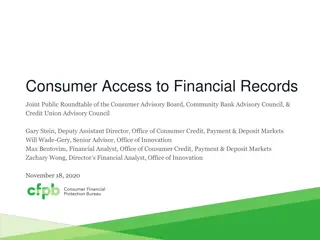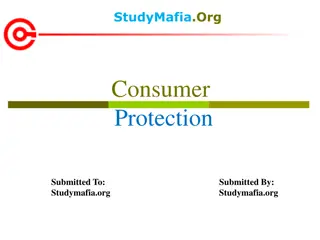Consumer Discretionary
The Consumer Discretionary sector encompasses a diverse range of industries with unique characteristics and challenges. This sector is currently facing issues such as low consumer sentiment, supply chain disruptions, geopolitical tensions, and economic uncertainties. Analyzing sector-wide performance is complex due to industry variations in profitability, pricing, and target consumers. Despite theoretical expectations, the sector is underperforming amidst a challenging business cycle marked by inflation concerns and interest rate hikes. **
Download Presentation

Please find below an Image/Link to download the presentation.
The content on the website is provided AS IS for your information and personal use only. It may not be sold, licensed, or shared on other websites without obtaining consent from the author.If you encounter any issues during the download, it is possible that the publisher has removed the file from their server.
You are allowed to download the files provided on this website for personal or commercial use, subject to the condition that they are used lawfully. All files are the property of their respective owners.
The content on the website is provided AS IS for your information and personal use only. It may not be sold, licensed, or shared on other websites without obtaining consent from the author.
E N D
Presentation Transcript
Consumer Discretionary Sanket Agrawal, Nicholas Bates, Kathy Cai, Joey Pinney
Market Cap: $8.43T Third largest sector in the index Largest Companies Overview Amazon Tesla Home Depot Alibaba Toyota
Index Characteristics Source: S&P Dow Jones Indices
Industries & Performance
Current Business Cycle Source: Fidelity
Currently Mid Cycle Theoretically, growth is peaking but slowing down Current Business Cycle Anomaly: Interest rates Generally, policies are neutral at this stage, however: Supply chain and geopolitical issues have contributed to high inflation Federal Reserve is planning to raise interest rates Difficult to compare to other times in history Peeling back of COVID-19 lockdowns Geopolitical issues Supply chain issues
Theoretically, the Consumer Discretionary sector should be doing well Implications for Consumer Discretionary Sector The sector does well in economic expansion and poor in recessions CD Sector is performing poorly Historically volatile and sensitive to many conditions Low consumer sentiment Uncertainty Supply chain issues Geopolitical Issues
Incredibly difficult to analyze this for a sector as a whole Ex: Automobile industry and Retail have vast differences Profitability & Pricing Industries within the sector often serve a different type of consumer There is little that is uniform across all industries Thus, looking at a snapshot of a few industries is helpful
Potential of New Entrants Low Power of Suppliers Low Power of Customers Medium Threat of Substitutes Medium Porter's Five Forces Analysis Competition Automobiles and Auto Components Household Appliances, Sports Equipments (Hardlines) Clothing, Apparels, Bedding (Softlines) Diversified Consumer Services (Interior Designing, Accounting, Taxation) Hotels, Restaurants, Leisure and Leisure Prodcuts Digital or Internet Retail Multi Retail Specialty Retail Media High Low Low Low High High Porter s Five Forces by industry Low Low High High High Medium Medium Medium High High Medium Low Medium Medium High Medium Medium Medium High High High Medium Medium High Medium Low Low High High Medium Medium High High Medium Medium
Economic expansion/recession (GDP growth) Consumer Discretionary does better in expansions Exceptions to the rule: off price retail Relevant Economic Indicators Consumer Confidence Sector does better when consumer confidence is high Disposable Income Unemployment Levels Home Sales
Regression Model: Disposable Income Lag: Two months (Disposable income level in January explains the Consumer Discretionary performance in March) Note: Using the monthly high of Vanguard s Consumer Discretionary Index Fund ETF (VCR) and Real Disposable Personal Income (Monthly, seasonally adjusted annual rate).
Regression Model: Consumer Sentiment Lag: One month (Consumer Sentiment in January explains the Consumer Discretionary performance in February) Note: Using the monthly high of Vanguard s Consumer Discretionary Index Fund ETF (VCR) and the University of Michigan s Consumer Sentiment index
Valuation- 10Y Cons Dis VS S&P 500
Valuation Analysis
Current SIM Portfolio Weight: 10.68% Current S&P 500 Weight: 11.73% Automobile Industry Recommendation GM & Ford: worth buying Otherwise: Hold (or even Buy) Selling at this point would be a panic move Limit to S&P 500 Level or below
Sources https://www.fidelity.com/learning-center/trading-investing/markets-sectors/business-cycle-update https://notesmatic.com/automotive-industry-five-forces-analysis/ https://eresearch.fidelity.com/eresearch/markets_sectors/sectors/sectors_in_market.jhtml?tab=learn§or=25 https://www.investopedia.com/terms/c/consumer- discretionary.asp#:~:text=Consumer%20discretionary%20is%20a%20sector,characterized%20by%20higher%20 disposable%20income. https://www.spglobal.com/spdji/en/indices/equity/sp-500-consumer-discretionary-sector/#overview BLOOMBERG -> GO























